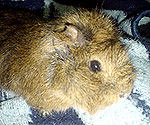guinea pigs history
 In 4000 BC the first common Guinea Pig was domesticated for food by the Inca, in the Andean region of South America, in what is now Peru and Bolivia. In these countries the Guinea Pigs continue to be a food source. In Peru Guinea Pigs are called cuy and are considered as a culinary delicacy. Guinea Pigs also play the role of evil-spirit collector in these country traditional healing rituals.
In 4000 BC the first common Guinea Pig was domesticated for food by the Inca, in the Andean region of South America, in what is now Peru and Bolivia. In these countries the Guinea Pigs continue to be a food source. In Peru Guinea Pigs are called cuy and are considered as a culinary delicacy. Guinea Pigs also play the role of evil-spirit collector in these country traditional healing rituals.
Guinea Pigs were brought to Europe by Dutch and English traders. As soon as they were introduced Guinea Pigs became popular as exotic pets. No one knows exactly why they came to be thought of as "pigs". Maybe it's because the sounds they make are similar to the sounds of the pigs, also they are built something like a pig with a large head relative to the body, a stout neck, and a rounded rump with no tail of any consequence.
when giant guinea pigs roamed the earth
By Roger Highfield, Science Editor
www.telegraph.co.uk
Herds of buffalo-sized guinea pigs roamed South America millions of years ago, according to a study of a fossil that is today recognised as the biggest rodent ever discovered.
Unearthed in the town of Urumaco, in an arid region of Venezuela 250 miles west of Caracas, the remains of the huge water-loving rodent and associated fossils and plant evidence suggest that the area was once a lush, tropical landscape roamed by giants.
Among local finds are 10ft-long turtles, huge catfish and at least three predators that dined on the giant guinea pigs - 33ft-long crocodiles, 10ft-tall flightless carnivorous birds, and marsupial cats the size of lions.
The rodent, an evolutionary sibling of the pet kept by thousands of children in Britain, probably dined on sea grass near an ancient river about eight million years ago.
Phoberomys pattersoni, named after Bryan Patterson, a London-born palaeontologist who did pioneering work in the region, measured 9ft long, stood 4ft tall, weighed more than 1,500lb, and had 8in front teeth. The unusually complete (90 per cent) fossil of Phoberomys was found in layers of sedimentary rock.
Dr Marcelo Sanchez-Villagra, from the University of Tubingen in Germany, one of the team who described Phoberomys today in the journal Science, said: "Imagine a weird guinea pig, but huge, with a long tail for balancing on its hind legs and continuously growing teeth." The creature is 10 times larger than the capybara, the biggest rodent living today. It was semi-aquatic and may have formed herds. Andrew Sugden, an evolutionary biology expert and international managing editor of Science, described the find as a "milestone . . . this research has broken the size barrier for rodents".
Rodents accounted for about 40 per cent of all mammal species and spanned a huge size range. "This new fossil stretches this size range by another order of magnitude," said Mr Sugden.
Fossil finds from the northern part of South America are rare, and today's work reinforces the theory that a massive river called the Paleo-Orinoco-Amazon once flowed parallel to the Andes mountain range through Urumaco.
Mr Sugden pointed out that South America was an island for tens of millions of years, until the emergence of a land bridge connecting it to Central America about three million years ago. During this time, South American animals were able to evolve in relative isolation.
As a result the continent became home to giant representatives of several mammalian groups, some of which survived until the arrival of humans.
Why the vast majority of today's rodents are so small is discussed in the journal by Prof R McNeill Alexander of the University of Leeds. He states that big rodents would be vulnerable to predators.
"Small mammals commonly escape predators by retiring into a refuge such as a burrow," he wrote. "Large mammals, too big to burrow, can generally escape only by running. Giant rodents may have been too slow and therefore vulnerable." Because of its size and posture, the new mammal, "a stunning animal", would have looked at a distance more like a cow or buffalo than a guinea pig, said Prof Alexander.
